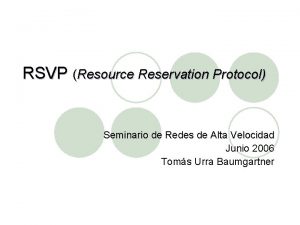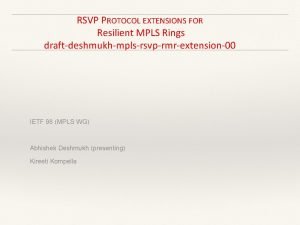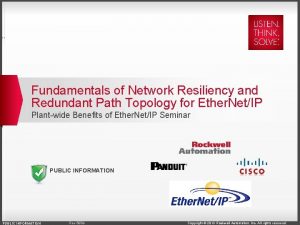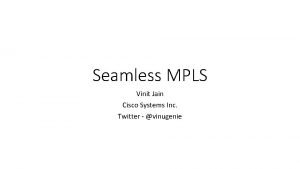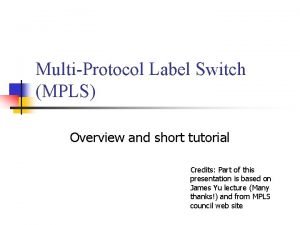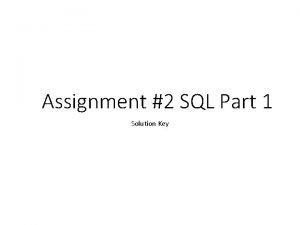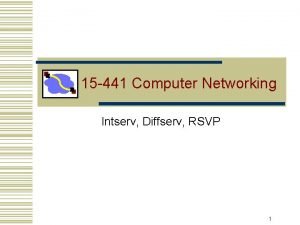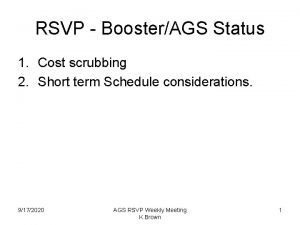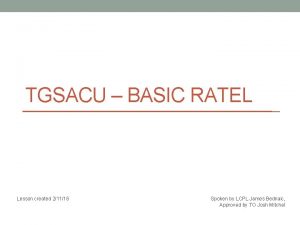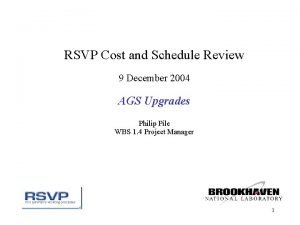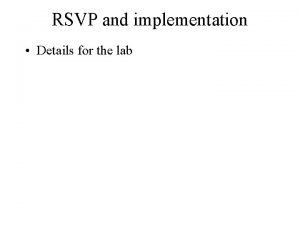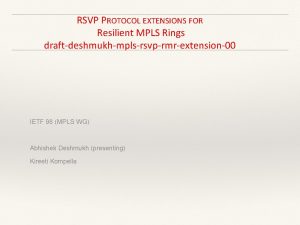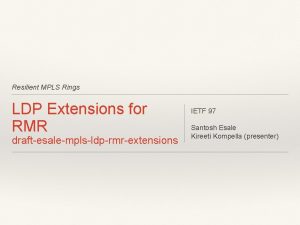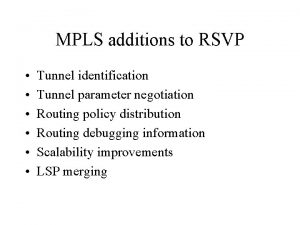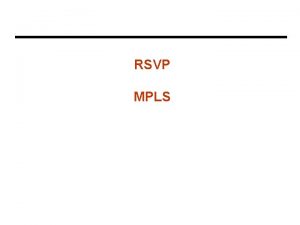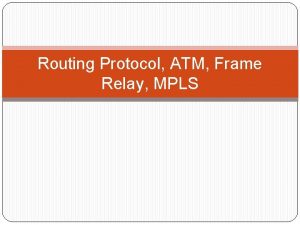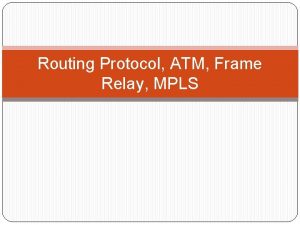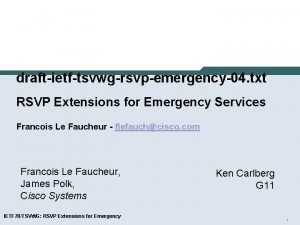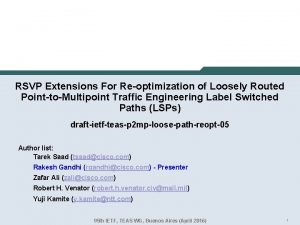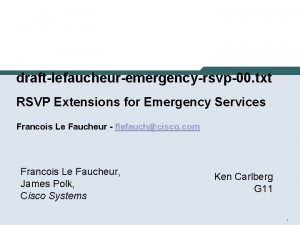RSVP PROTOCOL EXTENSIONS FOR Resilient MPLS Rings draftdeshmukhmplsrsvprmrextension00












- Slides: 12

RSVP PROTOCOL EXTENSIONS FOR Resilient MPLS Rings draft-deshmukh-mpls-rsvp-rmr-extension-00 IETF 98 (MPLS WG) Abhishek Deshmukh (presenting) Kireeti Kompella

MP 2 P Ring LSPs ❖ ❖ Ring LSPs form a loop. Ingress & Egress are same node for a ring LSPs. A Ring LSP is multipoint to point (MP 2 P) LSP ❖ ❖ Each transit node of ring LSP is also an ingress node for the ring LSP. The bandwidth of a ring LSP can change hop-to-hop (since it is MP 2 P) R 0 ---->R 1 ---->R 2 ---->R 3 ---->R 4 ---->R 5 ---->R 6 --->R 7 --->R 0 (CW LSP) R 0 ---->R 7 ---->R 6 ---->R 5 ---->R 4 ---->R 3 ---->R 2 --->R 1 --->R 0 (ACW LSP)

MP 2 P Ring LSPs 17 0 17 9 17 8 17 7 17 1 AC CW 17 6 17 5 17 2 Ring LSP RL 1 starts and ends on R 1. 17 3 17 4 Every node can be an ingress for RL 1. The egress for RL 1 is R 1. A ring of N nodes has 2 N ring LSPs, not N*(N-1)! None of these LSPs are configured!

Extensions - Session Object RMR_TUNNEL_IPv 4 Session Object Class = SESSION, RMR_TUNNEL_IPv 4 C-Type = TBD 0 1 2 3 0123456789012345678901 +-+-+-+-+-+-+-+-+-+-+-+-+-+-+-+ | Ring anchor node address | +-+-+-+-+-+-+-+-+-+-+-+-+-+-+-+ | Ring Flags | MBB ID | +-+-+-+-+-+-+-+-+-+-+-+-+-+-+-+ | Ring ID | +-+-+-+-+-+-+-+-+-+-+-+-+-+-+-+ Ring anchor node address: IPv 4 address of the anchor node. Each anchor node creates a LSP to itself. Ring Flags : 1 = Clockwise 2 = Anti-Clockwise MBB ID : A 16 -bit identifier used in the SESSION. This "Make- before-break" (MBB) ID is useful for graceful ring topology changes. Ring ID : A 32 -bit identifier for the ring. This number remains constant throughout the existence of ring.

Extensions - Sender Template Object Sender Template & Filter Spec Object 0 1 2 3 0123456789012345678901 +-+-+-+-+-+-+-+-+-+-+-+-+-+-+-+ | Ring tunnel sender address | +-+-+-+-+-+-+-+-+-+-+-+-+-+-+-+ | Must be zero | LSP ID | +-+-+-+-+-+-+-+-+-+-+-+-+-+-+-+ Ring tunnel sender address IPv 4 loopback address of the sender. LSP ID A 16 -bit identifier used in the SENDER_TEMPLATE. No changes to the format of SENDER_TEMPLATE and FILTER_SPEC objects. Only the semantics of these objects will slightly change. Different sender template & filter spec objects can be inserted by different nodes along the ring.

Multiple Sender Templates 17 9 17 10 17 1 17 8 17 7 ST 1 : Sender. Address-1 LSPID-1 17 2 ST 1 : Sender. Address-1 LSPID-1 ST 2 : Sender. Address-2 LSPID-1 17 3 17 6 17 5 17 4 ST 1 : Sender. Address-1 LSPID-1 ST 2 : Sender. Address-2 LSPID-1 ST 3 : Sender. Address-3 LSPID-1 ST 4 : Sender. Address-4 LSPID-1 When ring node R 4 receives a Path message initiated by anchor node R 1, the outgoing path message at R 4 will have the above sender templates. Similarly, the corresponding RESV message will have multiple FILTER_SPEC objects corresponding to the SENDER_TEMPLATE objects.

Ring LSPs: Bandwidth Management 17 9 17 10 17 1 17 8 17 7 Let’s say that the CW & AC anchor LSPs are already established for node 1 – LSP 1. (Green arrow LSP) Let’s focus on the CW LSP. 17 2 17 3 17 6 17 5 17 4 Now, node 5 wants to achieve BW increase from 0 G to 1 G (Blue arrow LSP) Similarly node 6 may want to increase BW (Purple arrow LSP) Now, let’s say, node 5 wants to increase bw again from 1 G to 2 G

Ring LSPs: Bandwidth Management 17 9 17 10 17 1 17 8 17 7 To increase the BW, node 5 will signal a Path message with a different sender-template object for “LSP 1” towards node 1. Ring tunnel sender address = node 5; lsp-id = 2 17 3 17 6 17 5 17 4 Node 1 will respond with Resv message for this new path if sufficient bw is available. This Resv message will have the appropriate filter-spec object. (Blue arrow LSP) Similarly node 6 can increase BW by signaling a Path message with different sender template object with its own address. (Purple arrow LSP) If node 5 wants to increase bw again from 1 G to 2 G, then it will again create a new Path message for “lsp 1” with Ring tunnel sender address = node 5 & lsp-id = 3

Ring LSPs: Bandwidth Management 17 9 17 10 17 1 17 8 17 7 ST 1 : Sender. Address-1 LSPID-1 17 2 ST 1 : Sender. Address-1 LSPID-1 ST 2 : Sender. Address-2 LSPID-1 17 3 17 6 17 5 17 4 ST 1 : Sender. Address-1 LSPID-1 ST 2 : Sender. Address-2 LSPID-1 ST 3 : Sender. Address-3 LSPID-1 ST 4 : Sender. Address-4 LSPID-1 ST 5 : Sender. Address-5 LSPID-2 ST 5 : Sender. Address-5 LSPID-3

Ring LSPs: Bandwidth Management ❖ ❖ ❖ If sufficient BW is not available at some Downstream (say node 9), then ring node 9 will generate Path. Err with the corresponding Sender Template Object. When ring node 5 no longer needs the bw reservation, then ring node 5 will originate a new Path message with a new Sender Template Object with 0 bw. Every downstream node will then remove bw allocated on the corresponding link. Note that we will not actually change any label as part of this bw increase/decrease. So, the label remains same as it is signaled initially for the anchor LSP. Only BW accounting changes when these Path messages get signaled.

Next Steps ❖ Need more feedback from the working group. ❖ Request for MPLS WG document.

Thank you !
